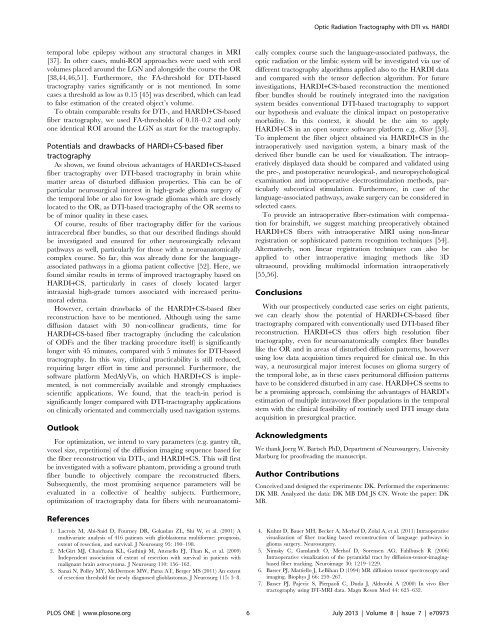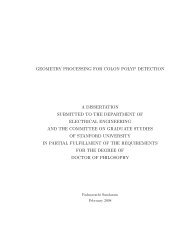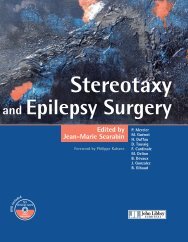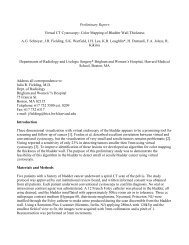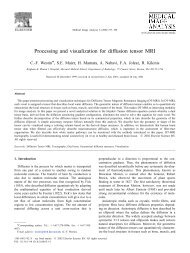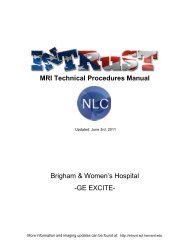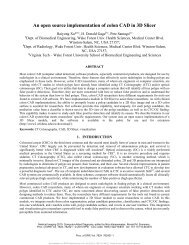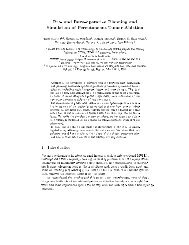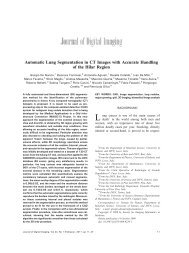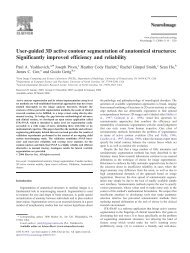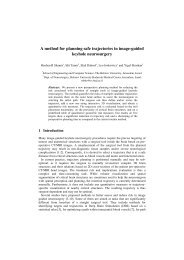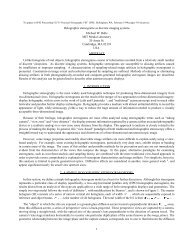<strong>Optic</strong> <strong>Radiation</strong> <strong>Tractography</strong> with DTI vs. HARDItemporal lobe epilepsy without any structural changes <strong>in</strong> MRI[37]. In other cases, multi-ROI approaches were used with seedvolumes placed around the LGN and alongside the course the OR[38,44,46,51]. Furthermore, the FA-threshold for DTI-basedtractography varies significantly or is not mentioned. In somecases a threshold as low as 0.15 [45] was described, which can leadto false estimation of the created object’s volume.To obta<strong>in</strong> comparable results for DTI-, and HARDI+CS-basedfiber tractography, we used FA-thresholds of 0.18–0.2 and onlyone identical ROI around the LGN as start for the tractography.Potentials and drawbacks of HARDI+CS-based fibertractographyAs shown, we found obvious advantages of HARDI+CS-basedfiber tractography over DTI-based tractography <strong>in</strong> bra<strong>in</strong> whitematter areas of disturbed diffusion properties. This can be ofparticular neurosurgical <strong>in</strong>terest <strong>in</strong> high-grade glioma surgery ofthe temporal lobe or also for low-grade gliomas which are closelylocated to the OR, as DTI-based tractography of the OR seems tobe of m<strong>in</strong>or quality <strong>in</strong> these cases.Of course, results of fiber tractography differ for the various<strong>in</strong>tracerebral fiber bundles, so that our described f<strong>in</strong>d<strong>in</strong>gs shouldbe <strong>in</strong>vestigated and ensured for other neurosurgically relevantpathways as well, particularly for those with a neuroanatomicallycomplex course. So far, this was already done for the languageassociatedpathways <strong>in</strong> a glioma patient collective [52]. Here, wefound similar results <strong>in</strong> terms of improved tractography based onHARDI+CS, particularly <strong>in</strong> cases of closely located larger<strong>in</strong>traaxial high-grade tumors associated with <strong>in</strong>creased peritumoraledema.However, certa<strong>in</strong> drawbacks of the HARDI+CS-based fiberreconstruction have to be mentioned. Although us<strong>in</strong>g the samediffusion dataset with 30 non-coll<strong>in</strong>ear gradients, time forHARDI+CS-based fiber tractography (<strong>in</strong>clud<strong>in</strong>g the calculationof ODFs and the fiber track<strong>in</strong>g procedure itself) is significantlylonger with 45 m<strong>in</strong>utes, compared with 5 m<strong>in</strong>utes for DTI-basedtractography. In this way, cl<strong>in</strong>ical practicability is still reduced,requir<strong>in</strong>g larger effort <strong>in</strong> time and personnel. Furthermore, thesoftware platform MedAlyVis, on which HARDI+CS is implemented,is not commercially available and strongly emphazisesscientific applications. We found, that the teach-<strong>in</strong> period issignificantly longer compared with DTI-tractography applicationson cl<strong>in</strong>ically orientated and commercially used navigation systems.OutlookReferences1. Lacroix M, Abi-Said D, Fourney DR, Gokaslan ZL, Shi W, et al. (2001) Amultivariate analysis of 416 patients with glioblastoma multiforme: prognosis,extent of resection, and survival. J Neurosurg 95: 190–198.2. McGirt MJ, Chaichana KL, Gath<strong>in</strong>ji M, Attenello FJ, Than K, et al. (2009)Independent association of extent of resection with survival <strong>in</strong> patients withmalignant bra<strong>in</strong> astrocytoma. J Neurosurg 110: 156–162.3. Sanai N, Polley MY, McDermott MW, Parsa AT, Berger MS (2011) An extentof resection threshold for newly diagnosed glioblastomas. J Neurosurg 115: 3–8.For optimization, we <strong>in</strong>tend to vary parameters (e.g. gantry tilt,voxel size, repetitions) of the diffusion imag<strong>in</strong>g sequence based forthe fiber reconstruction via DTI-, and HARDI+CS. This will firstbe <strong>in</strong>vestigated with a software phantom, provid<strong>in</strong>g a ground truthfiber bundle to objectively compare the reconstructed fibers.Subsequently, the most promis<strong>in</strong>g sequence parameters will beevaluated <strong>in</strong> a collective of healthy subjects. Furthermore,optimization of tractography data for fibers with neuroanatomicallycomplex course such the language-associated pathways, theoptic radiation or the limbic system will be <strong>in</strong>vestigated via use ofdifferent tractography algorithms applied also to the HARDI dataand compared with the tensor deflection algorithm. For future<strong>in</strong>vestigations, HARDI+CS-based reconstruction the mentionedfiber bundles should be rout<strong>in</strong>ely <strong>in</strong>tegrated <strong>in</strong>to the navigationsystem besides conventional DTI-based tractography to supportour hypothesis and evaluate the cl<strong>in</strong>ical impact on postoperativemorbidity. In this context, it should be the aim to applyHARDI+CS <strong>in</strong> an open source software platform e.g. <strong>Slicer</strong> [53].To implement the fiber object obta<strong>in</strong>ed via HARDI+CS <strong>in</strong> the<strong>in</strong>traoperatively used navigation system, a b<strong>in</strong>ary mask of thederived fiber bundle can be used for visualization. The <strong>in</strong>traoperativelydisplayed data should be compared and validated us<strong>in</strong>gthe pre-, and postoperative neurological-, and neuropsychologicalexam<strong>in</strong>ation and <strong>in</strong>traoperative electrostimulation methods, particularlysubcortical stimulation. Furthermore, <strong>in</strong> case of thelanguage-associated pathways, awake surgery can be considered <strong>in</strong>selected cases.To provide an <strong>in</strong>traoperative fiber-estimation with compensationfor bra<strong>in</strong>shift, we suggest match<strong>in</strong>g preoperatively obta<strong>in</strong>edHARDI+CS fibers with <strong>in</strong>traoperative MRI us<strong>in</strong>g non-l<strong>in</strong>earregistration or sophisticated pattern recognition techniques [54].Alternatively, non l<strong>in</strong>ear registration techniques can also beapplied to other <strong>in</strong>traoperative imag<strong>in</strong>g methods like <strong>3D</strong>ultrasound, provid<strong>in</strong>g multimodal <strong>in</strong>formation <strong>in</strong>traoperatively[55,56].ConclusionsWith our prospectively conducted case series on eight patients,we can clearly show the potential of HARDI+CS-based fibertractography compared with conventionally used DTI-based fiberreconstruction. HARDI+CS thus offers high resolution fibertractography, even for neuroanatomically complex fiber bundleslike the OR and <strong>in</strong> areas of disturbed diffusion patterns, howeverus<strong>in</strong>g low data acquisition times required for cl<strong>in</strong>ical use. In thisway, a neurosurgical major <strong>in</strong>terest focuses on glioma surgery ofthe temporal lobe, as <strong>in</strong> these cases peritumoral diffusion patternshave to be considered disturbed <strong>in</strong> any case. HARDI+CS seems tobe a promis<strong>in</strong>g approach, comb<strong>in</strong><strong>in</strong>g the advantages of HARDI’sestimation of multiple <strong>in</strong>travoxel fiber populations <strong>in</strong> the temporalstem with the cl<strong>in</strong>ical feasibility of rout<strong>in</strong>ely used DTI image dataacquisition <strong>in</strong> presurgical practice.AcknowledgmentsWe thank Joerg W. Bartsch PhD, Department of Neurosurgery, UniversityMarburg for proofread<strong>in</strong>g the manuscript.Author ContributionsConceived and designed the experiments: DK. Performed the experiments:DK MB. Analyzed the data: DK MB DM JS CN. Wrote the paper: DKMB.4. Kuhnt D, Bauer MH, Becker A, Merhof D, Zolal A, et al. (2011) Intraoperativevisualization of fiber track<strong>in</strong>g based reconstruction of language pathways <strong>in</strong>glioma surgery. Neurosurgery.5. Nimsky C, Ganslandt O, Merhof D, Sorensen AG, Fahlbusch R (2006)Intraoperative visualization of the pyramidal tract by diffusion-tensor-imag<strong>in</strong>gbasedfiber track<strong>in</strong>g. Neuroimage 30: 1219–1229.6. Basser PJ, Mattiello J, LeBihan D (1994) MR diffusion tensor spectroscopy andimag<strong>in</strong>g. Biophys J 66: 259–267.7. Basser PJ, Pajevic S, Pierpaoli C, Duda J, Aldroubi A (2000) In vivo fibertractography us<strong>in</strong>g DT-MRI data. Magn Reson Med 44: 625–632.PLOS ONE | www.plosone.org 6 July 2013 | Volume 8 | Issue 7 | e70973
<strong>Optic</strong> <strong>Radiation</strong> <strong>Tractography</strong> with DTI vs. HARDI8. Friman O, Farneback G, West<strong>in</strong> CF (2006) A Bayesian approach for stochasticwhite matter tractography. IEEE Trans Med Imag<strong>in</strong>g 25: 965–978.9. Mori S, van Zijl PC (2002) <strong>Fiber</strong> track<strong>in</strong>g: pr<strong>in</strong>ciples and strategies - a technicalreview. NMR Biomed 15: 468–480.10. Alexander DC, Barker GJ, Arridge SR (2002) Detection and model<strong>in</strong>g of non-Gaussian apparent diffusion coefficient profiles <strong>in</strong> human bra<strong>in</strong> data. MagnReson Med 48: 331–340.11. Frank LR (2001) Anisotropy <strong>in</strong> high angular resolution diffusion-weighted MRI.Magn Reson Med 45: 935–939.12. Descoteaux M, Deriche R, Knosche TR, Anwander A (2009) Determ<strong>in</strong>istic andprobabilistic tractography based on complex fibre orientation distributions.IEEE Trans Med Imag<strong>in</strong>g 28: 269–286.13. Behrens TE, Berg HJ, Jbabdi S, Rushworth MF, Woolrich MW (2007)Probabilistic diffusion tractography with multiple fibre orientations: What canwe ga<strong>in</strong>? Neuroimage 34: 144–155.14. Tuch DS, Reese TG, Wiegell MR, Makris N, Belliveau JW, et al. (2002) Highangular resolution diffusion imag<strong>in</strong>g reveals <strong>in</strong>travoxel white matter fiberheterogeneity. Magn Reson Med 48: 577–582.15. Frank LR (2002) Characterization of anisotropy <strong>in</strong> high angular resolutiondiffusion-weighted MRI. Magn Reson Med 47: 1083–1099.16. Anderson AW (2005) Measurement of fiber orientation distributions us<strong>in</strong>g highangular resolution diffusion imag<strong>in</strong>g. Magn Reson Med 54: 1194–1206.17. Michailovich O, Rathi Y (2010) Fast and accurate reconstruction of HARDIdata us<strong>in</strong>g compressed sens<strong>in</strong>g. Med Image Comput Comput Assist Interv 13:607–614.18. Michailovich O, Rathi Y (2010) On approximation of orientation distributionsby means of spherical ridgelets. IEEE Trans Image Process 19: 461–477.19. Michailovich O, Rathi Y, Dolui S (2011) Spatially regularized compressedsens<strong>in</strong>g for high angular resolution diffusion imag<strong>in</strong>g. IEEE Trans Med Imag<strong>in</strong>g30: 1100–1115.20. Candes E, Romberg J (2006) Quantitative robust uncer ta<strong>in</strong>ty pr<strong>in</strong>ciples andoptimally sparse decompositions. Foundations of Computional Mathematics 6:227–254.21. Candes E, Romberg J, Tao T (2006) Robust uncerta<strong>in</strong>ty pr<strong>in</strong>ciples: Exactsignalreconstrruction from highly <strong>in</strong>comlete frequency <strong>in</strong>formation. IEEE Transactionsand Information Theory 52: 489–509.22. Donoho D (2006) Compressed sens<strong>in</strong>g. IEEE Transactions and InformationTheory 52: 1289–1306.23. Merhof D (2007) Reconstruction and visualization of neuronal pathways fromdiffusion tensor data. Erlangen, Germany: University of Erlangen-Nuremberg.24. Landgraf P, Richter M, Merhof D (2011) Anisotropy of HARDI DiffusionProfiles based on the L2-Norm. Bildverarbeitung für die Mediz<strong>in</strong> (BVM).25. Leuret F, Gratiolet L-P (1839) Anatomie Comparee du Syste’me Nerveux. J-BBaille’re et fils II.26. Meyer A (1907) The connections of the occipital lobes and present status of thecerebral visual affections. Trans Assoc Am Phys 22: 7–23.27. Sherbondy AJ, Dougherty RF, Napel S, Wandell BA (2008) Identify<strong>in</strong>g thehuman optic radiation us<strong>in</strong>g diffusion imag<strong>in</strong>g and fiber tractography. J Vis 8: 1211–11.28. Parraga RG, Ribas GC, Well<strong>in</strong>g LC, Alves RV, de Oliveira E (2012)Microsurgical anatomy of the optic radiation and related fibers <strong>in</strong> 3-dimensionalimages. Neurosurgery 71: ons160–172.29. Kl<strong>in</strong>gler J (1935) Development of a macroscoptic preparation of the bra<strong>in</strong>through the process of freez<strong>in</strong>g (<strong>in</strong> German). Schweiz Arch Neurol Psychiatr:247–256.30. S<strong>in</strong>coff EH, Tan Y, Abdulrauf SI (2004) White matter fiber dissection of theoptic radiations of the temporal lobe and implications for surgical approaches tothe temporal horn. J Neurosurg 101: 739–746.31. Ture U, Yasargil MG, Friedman AH, Al-Mefty O (2000) <strong>Fiber</strong> dissectiontechnique: lateral aspect of the bra<strong>in</strong>. Neurosurgery 47: 417–426; discussion426–417.32. Roberts DW, Strohbehn JW, Hatch JF, Murray W, Kettenberger H (1986) Aframeless stereotaxic <strong>in</strong>tegration of computerized tomographic imag<strong>in</strong>g and theoperat<strong>in</strong>g microscope. J Neurosurg 65: 545–549.33. Gasser T, Sandalcioglu E, Schoch B, Gizewski E, Forst<strong>in</strong>g M, et al. (2005)Functional magnetic resonance imag<strong>in</strong>g <strong>in</strong> anesthetized patients: a relevant steptoward real-time <strong>in</strong>traoperative functional neuroimag<strong>in</strong>g. Neurosurgery 57: 94–99; discussion 94–99.34. Stadlbauer A, Prante O, Nimsky C, Salomonowitz E, Buchfelder M, et al. (2008)Metabolic imag<strong>in</strong>g of cerebral gliomas: spatial correlation of changes <strong>in</strong> O-(2-18F-fluoroethyl)-L-tyros<strong>in</strong>e PET and proton magnetic resonance spectroscopicimag<strong>in</strong>g. J Nucl Med 49: 721–729.35. Assaf Y, Pasternak O (2008) Diffusion tensor imag<strong>in</strong>g (DTI)-based white mattermapp<strong>in</strong>g <strong>in</strong> bra<strong>in</strong> research: a review. J Mol Neurosci 34: 51–61.36. Jones DK (2004) The effect of gradient sampl<strong>in</strong>g schemes on measures derivedfrom diffusion tensor MRI: a Monte Carlo study. Magn Reson Med 51: 807–815.37. Chen X, Weigel D, Ganslandt O, Fahlbusch R, Buchfelder M, et al. (2007)Diffusion tensor-based fiber track<strong>in</strong>g and <strong>in</strong>traoperative neuronavigation for theresection of a bra<strong>in</strong>stem cavernous angioma. Surg Neurol 68: 285–291;discussion 291.38. Yamamoto A, Miki Y, Urayama S, Fushimi Y, Okada T, et al. (2007) Diffusiontensor fiber tractography of the optic radiation: analysis with 6-, 12-, 40-, and 81-directional motion-prob<strong>in</strong>g gradients, a prelim<strong>in</strong>ary study. AJNRAm J Neuroradiol 28: 92–96.39. Nilsson D, Starck G, Ljungberg M, Ribbel<strong>in</strong> S, Jonsson L, et al. (2007)Intersubject variability <strong>in</strong> the anterior extent of the optic radiation assessed bytractography. Epilepsy Res 77: 11–16.40. Duffau H, Denvil D, Lopes M, Gaspar<strong>in</strong>i F, Cohen L, et al. (2002)Intraoperative mapp<strong>in</strong>g of the cortical areas <strong>in</strong>volved <strong>in</strong> multiplication andsubtraction: an electrostimulation study <strong>in</strong> a patient with a left parietal glioma.J Neurol Neurosurg Psychiatry 73: 733–738.41. Berger MS (1996) M<strong>in</strong>imalism through <strong>in</strong>traoperative functional mapp<strong>in</strong>g. Cl<strong>in</strong>Neurosurg 43: 324–337.42. Merhof D, Meister M, B<strong>in</strong>gol E, Nimsky C, Gre<strong>in</strong>er G (2009) Isosurface-basedgeneration of hulls encompass<strong>in</strong>g neuronal pathways. Stereotact FunctNeurosurg 87: 50–60.43. Nimsky C, Ganslandt O, Hastreiter P, Wang R, Benner T, et al. (2007)Preoperative and <strong>in</strong>traoperative diffusion tensor imag<strong>in</strong>g-based fiber track<strong>in</strong>g <strong>in</strong>glioma surgery. Neurosurgery 61: 178–185; discussion 186.44. Wu W, Rigolo L, O’Donnell LJ, Norton I, Shriver S, et al. (2012) Visualpathway study us<strong>in</strong>g <strong>in</strong> vivo diffusion tensor imag<strong>in</strong>g tractography tocomplement classic anatomy. Neurosurgery 70: 145–156; discussion 156.45. Tao XF, Wang ZQ, Gong WQ, Jiang QJ, Shi ZR (2009) A new study ondiffusion tensor imag<strong>in</strong>g of the whole visual pathway fiber bundle and cl<strong>in</strong>icalapplication. Ch<strong>in</strong> Med J (Engl) 122: 178–182.46. Staempfli P, Rienmueller A, Reischauer C, Valavanis A, Boesiger P, et al. (2007)Reconstruction of the human visual system based on DTI fiber track<strong>in</strong>g. J MagnReson Imag<strong>in</strong>g 26: 886–893.47. Frey S, Campbell JS, Pike GB, Petrides M (2008) Dissociat<strong>in</strong>g the humanlanguage pathways with high angular resolution diffusion fiber tractography.J Neurosci 28: 11435–11444.48. Prckovska V, Peeters TH, van Almsick M, Romeny B, Vilanova A (2011) FusedDTI/HARDI visualization. IEEE Trans Vis Comput Graph 17: 1407–1419.49. Reisert M, Mader I, Anastasopoulos C, Weigel M, Schnell S, et al. (2011) Globalfiber reconstruction becomes practical. Neuroimage 54: 955–962.50. K<strong>in</strong>oshita M, Yamada K, Hashimoto N, Kato A, Izumoto S, et al. (2005) <strong>Fiber</strong>track<strong>in</strong>gdoes not accurately estimate size of fiber bundle <strong>in</strong> pathologicalcondition: <strong>in</strong>itial neurosurgical experience us<strong>in</strong>g neuronavigation and subcorticalwhite matter stimulation. Neuroimage 25: 424–429.51. Wang F, Sun T, Li XG, Liu NJ (2008) Diffusion tensor tractography of thetemporal stem on the <strong>in</strong>ferior limit<strong>in</strong>g sulcus. J Neurosurg 108: 775–781.52. Kuhnt D, Bauer MH, Egger J, Richter M, Kapur T, et al. (2013) <strong>Fiber</strong>tractography based on diffusion tensor imag<strong>in</strong>g compared with high-angularresolutiondiffusion imag<strong>in</strong>g with compressed sens<strong>in</strong>g: <strong>in</strong>itial experience.Neurosurgery 72 Suppl 1: 165–175.53. The <strong>Slicer</strong> Community (2012). <strong>3D</strong> <strong>Slicer</strong>. Available: http:/www.slicer.org/.Accessed 2012 Aug 12.54. Archip N, Clatz O, Whalen S, Kacher D, Fedorov A, et al. (2007) Non-rigidalignment of pre-operative MRI, fMRI, and DT-MRI with <strong>in</strong>tra-operative MRIfor enhanced visualization and navigation <strong>in</strong> image-guided neurosurgery.Neuroimage 35: 609–624.55. Cao A, Thompson RC, Dumpuri P, Dawant BM, Galloway RL, et al. (2008)Laser range scann<strong>in</strong>g for image-guided neurosurgery: <strong>in</strong>vestigation of image-tophysicalspace registrations. Med Phys 35: 1593–1605.56. Miga MI, S<strong>in</strong>ha TK, Cash DM, Galloway RL, Weil RJ (2003) Cortical surfaceregistration for image-guided neurosurgery us<strong>in</strong>g laser-range scann<strong>in</strong>g. IEEETrans Med Imag<strong>in</strong>g 22: 973–985.PLOS ONE | www.plosone.org 7 July 2013 | Volume 8 | Issue 7 | e70973


